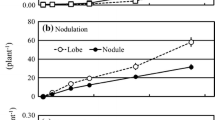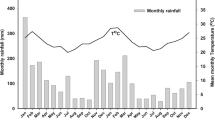Summary
The productivity of three species of Azolla (A. pinnata, A. filiculoides andA. caroliniana) in outdoor culture has been evaluated at different planting densities. The highest yields were obtained with biomass concentration ranging from 40 to 70g d.w. m−2. The mean productivity over a 90 days period (from May 10th to August 10th) ranged from 10g d.w. m−2 day−1 forA. filiculoides up to 11.5 g d.w. m−2 day−1 forA. caroliniana. The nitrogen content of the dried biomasses was 48.3 mg (g d.w.)−1 forA. pinnata, 51.5mg (g d.w.)−1 forA. filiculoides and 52.3 mg (g d.w.)−1 forA. caroliniana. Very little variations of the nitrogen content of the ferns during the experimental period were observed.
The nitrogen-fixing efficiency of the Azolla-Anabaena azollae symbiosis grown in outdoor conditions was evaluated both by direct measurement of the amount of N2 fixed by the culture and by the C2H2-reduction and H2-evolution tests in an air atmosphere. These tests were performed outdoor under the same environmental conditions as the growing cultures. For all the species the ratios of C2H2-reduced to N2-fixed were unexpectedly low, ranging from 2.04 (A. pinnata) to 1.50 (A. caroliniana).
The results suggest that the reliability of the C2H2-reduction assay, particularly when applied to complex biological N2-fixing systems, must be re-examined.
Similar content being viewed by others
References
Arima Y 1981 Respiration and efficiency of N2-fixation by nodules formed with a H2-uptake positive strain ofRhizobium japonicum. Soil Sci. Plant Nutr. 27, 115–119.
Favilli F, Materassi R, Balloni W and Florenzano G 1983 The fate ofAzolla biomass in the soil. Trans. VIIIth Int. Symp. ‘Humus et Planta’ Prague.
Florenzano G, Balloni W, Materassi R and Torzillo G 1980 Preliminary report on the production of a humo-mineral complex by Azolla in mass culture. Agric. Ital. 109, 283–287.
Hadfield D J and Bules W A 1969 Adenosine triphosphate requirement of nitrogenase fromAzotobacter vinelandii Biochemistry 8, 5103–5108.
Hallebeck P C 1983 Immobilized micro-organisms for hydrogen and ammonia production. Enzyme Microb. Technol. 5, 171–180.
Hardy R W F 1979 Reducible substrates of nitrogenaseIn A Treatise of Dinitrogen Fixation Sec, I–II Eds. R W F Hardy, F Bottomley and R C Burn. J. Wiley and Sons N.Y. pp 515–568.
Lumpkin T A and Plucknett D A 1980 Azolla: botany, physiology and use as a green manure. Economic Bot. 34, 111–153.
Margheri M C, Materassi R, Balloni W and Paoletti C 1979 Coltura massiva diAzolla caroliniana: prime esperienze in Italia ed importanza agronomica del processo. Agric. Ital. 108, 199–210.
Margheri M C, Tomaselli L and Filpi C 1982 Research on the mass culture ofAzolla caroliniana andA. filiculoides in Italy. International workshop on practical application of Azolla for rice production. Mayaguez. Puerto Rico.
Minchin F R and Pate J S 1973 The carbon balance of a legume and the functional economy of its root nodules. J. Exp. Bot. 24, 259–271.
Minchin F R, Witty J F, Sheehy J E and Muller M 1983 A major error in the acetylene reduction assay: decreases in nodular nitrogenase activity under assay conditions. J. Exp. Bot. 34, 641–649.
Peters G A 1975 The Azolla-Anabaena azollae relationship III. Studies on metabolic capabilities and a further characterization of the symbiont. Arch. Microbiol. 103, 113–122.
Peters G A and Mayne B C 1974 The Azolla-Anabaena azollae relationship. I. Characterization of the association. Plant. Physiol. 53, 813–819.
Peters G A, Toia R E Jr and Lough S M 1977 Azolla-Anabaena azollae relationship. V. N2-fixing, acetylene reduction and H2 production. Plant. Physiol. 59, 1021–1025.
Rivera-Ortiz J M and Burris R H 1975 Interactions among substrates and inhibitors of nitrogenase. J. Bacteriol. 123, 537–545.
Schubert K R and Evans H J 1976 Hydrogen evolution: a major factor affecting the efficiency of nitrogen fixation in nodulated symbionts. Proc. Nat. Acad. Sci. USA 73, 1207–1211.
Simpson F B and Burris R H 1984 A nitrogen pressure of 50 atmosphere does not prevent evolution of hydrogen by nitrogenase. Science. 224, 1095–1097.
Talley S N and Talley B I 1976 Nitrogen fixation by Azolla in rice fields.In Proc. First Int. Symp. on Nitrogen Fixation. Eds. W E Newton and I Nyman. Washington State Univ. Press. Pullmann, pp 259–282.
Tel-Or E, Sandovsky T, Arad H, Keysary A and Kobiler D 1984 The unique properties of the symbioticAnabaena azollae in the water fern Azolla: metabolism and intercellular recognition.In Advances in Nitrogen Fixation Research. Eds. C Veeger and W E Newton pp 461–465.
Tel-Or E, Sandovsky T, Kobilier D, Arad C and Weinberg R 1983 The unique properties of the symbiotic Anabaena in the water fern Azolla.In Photosynthetic Prokaryotes: Cell Differentiation and Function. Eds. G C Papageorgiou and L. Parker. Elsevier Sci. Pub. Co. Inc. pp 303–314.
Turner G L and Gibson A H 1980 Measurement of nitrogen fixation by indirect means.In Methods for Evaluating Biological Nitrogen Fixation. Ed. F J Bergersen, J. Wiley and Sons. N.Y.; pp 111–138.
Watanabe I 1982Azolla-Anabaena symbiosis: its physiology and use in tropical agriculture.In Microbiology of Tropical Soils and Plant Productivity. Eds. Y R Dommergues and H G Diem. M Nijhoff/W Junk Publs: pp 169–185.
Yatazawa M, Tomomatsu N, Hosoda N and Nunome K 1980 Nitrogen fixation inAzolla-Anabaena symbiosis as affected by mineral nutrient status. Soil Sci. Plant. Nutr. 26, 415–426.
Author information
Authors and Affiliations
Rights and permissions
About this article
Cite this article
Vincenzini, M., Margheri, M.C. & Sili, C. Outdoor mass culture ofAzolla spp.: yields and efficiencies of nitrogen fixation. Plant Soil 86, 57–67 (1985). https://doi.org/10.1007/BF02185025
Received:
Issue Date:
DOI: https://doi.org/10.1007/BF02185025




